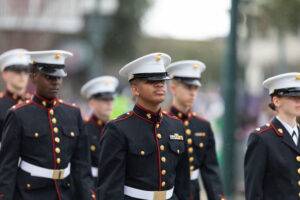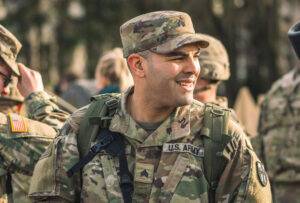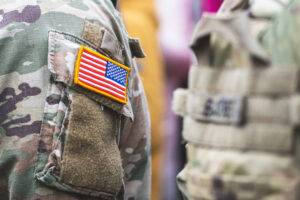
The appearance of U.S. Department of Defense (DoD) visual information does not imply or constitute DoD endorsement.
Modern warfare is an information-intensive business. Hyper-sensitive electronic systems search the sea and sky from multi-billion dollar aircraft carriers and submarines. Air Force deployments happen with satellite-linked drones under the controls of pilots located on the other side of the world. Even the humble grunt ends up staring at Blue Force Tracker screens and communicating through encrypted comm systems on the battlefield.
Mastery of all those high-tech tools, and the broad range of jobs required to keep a fighting force effective, requires education. It’s woven into the fabric of the modern military, in every single branch.
One great thing you will learn about the military is that it’s a culture built around learning. Cross-training is an obsession in a mission-critical world where any specialist can be put out of action at any time.
On your way to “Aiming High,” or becoming “Army Strong,” or “Forged by the Sea,” or becoming one of “The Few, The Proud,” you’re going to get a lot of training. You may pick up skills ranging from calling in a fire mission to tearing down and rebuilding a nuclear reactor cooling water pump.
If you play your cards right, a lot of that active duty training experience can send you to college on the military’s time and dime. Some of it may later turn into college credits that civilian colleges are glad to accept. Either way, active duty military service offers a huge opportunity to put in a foundation for successful careers in both the service and the civilian world.
Explore Your Benefits Options
Turning Active Duty Military Experience Into Long-term Career Prospects
 As a rule, your artillery spotting prowess isn’t going to get you a lot of attention in the civilian world. But today’s American military is high-tech and cross-disciplinary. There are military occupational specializations (MOS) for everything from computer technicians to dentists.
As a rule, your artillery spotting prowess isn’t going to get you a lot of attention in the civilian world. But today’s American military is high-tech and cross-disciplinary. There are military occupational specializations (MOS) for everything from computer technicians to dentists.
There is a lot going on in today’s military that requires the sort of advanced skills that only come with a college degree.
Even if you joined up thinking you might take advantage of all the terrific veteran’s educational benefits that come after your service, you may be surprised to find how many college benefits you can get while still on active duty.
Those benefits aren’t just there to set you up for a cushy job after discharge, of course. Their main purpose, in fact, is to make you better at your role in the military. These training opportunities are important even if you plan to make a career in the service. Promotions, paycheck, and desirable billets will all depend on getting the right training along the way.
So pay attention to all the ways Uncle Sam is ready to help you go to college while you’re still in uniform.
The American Military Is a Great Big Learning Machine
The military training pipeline is the very first thing you’re going to encounter when you enter the service. Unfortunately, it’s going to be the raw end of that pipeline: basic training is nobody’s idea of a good time.
After you get through your initial training, you’ll start to find more advanced and more useful service schools opening up. Some of those will teach skills at a college level that you may receive credit for later.
Your assigned MOS (Military Occupational Specialty) will almost always have some sort of immediate follow-on training after basic, though. Depending on the job, the military schools you will be sent to may be nearly equivalent to college in many ways—and you may receive college credit for that training eventually!
Your MOS Could Reveal Something About Your In-Service Education Options and How that Could Connect to a Career in the Civilian World
 Military Occupational Specialty codes, or an MOS codes, as you know, are alphanumeric classifiers used by each service to identify a specific job. They range from the basic rifleman to the power line distribution specialist to the exotic nodal network systems operator-maintainer.
Military Occupational Specialty codes, or an MOS codes, as you know, are alphanumeric classifiers used by each service to identify a specific job. They range from the basic rifleman to the power line distribution specialist to the exotic nodal network systems operator-maintainer.
That function is about all they have in common between the branches, though. In fact, only the Army and Marines even call them MOS codes… for the Air Force, it’s an Air Force Specialty Code, and the Navy used the Navy Enlisted Classification System.
But even the Army and Marines don’t use the same code to describe the same role. An intelligence analyst in the Army holds a 96B MOS; in the Marines, the job is categorized as a 0231.
Still, most people just refer to these codes as a MOS when they are talking about military jobs in general, rather than a specific service.
Your MOS is a big deal from the educational perspective, though. No matter what branch you belong to, your MOS will describe in detail what you are expected to be able to handle in your role. In each service, some of that long classifier will tell you what schools you may be eligible or required to attend as part of your MOS.
In the Army, for instance, the fifth character of your MOS will indicate if you are qualified to attend a specialty school, such as the Army Court Reporter School. So, it’s wise to pay attention to your MOS!
But the military also has more flexible options to help you get schooling while you are on active duty. You can pursue any number of programs relevant to any kind of degree, not just skills in your current MOS. And that can build your education toward a better job in the military or a hot career in the civilian world.
Common College Benefits for Active Duty Military Members
Many of the educational benefits you can tap into on active duty are funded by the Department of Defense. And that means you can take advantage of them no matter what service you join, what your MOS is, or what rank you hold.
Each branch may list these programs under slightly different names, but all now offer the same annual cap on Military Tuition Assistance – $4,500 as of 2022.
Military Tuition Assistance Pays for a Degree of Your Choice While on Active Duty
 One of the best benefit programs available to all ranks in all branches of the American military is Military Tuition Assistance – TA.
One of the best benefit programs available to all ranks in all branches of the American military is Military Tuition Assistance – TA.
TA is a benefit you can use for your own education entirely separate from any official service training. Of course, that means that you need to do it on your own hours, if you have any of those left after standing post or swabbing decks.
But it’s a pretty generous benefit if you have the time to tap into it. TA will cover up to 100 percent of your college tuition toward either undergraduate or graduate degree programs, not to exceed a rate of $250 per semester hour or a total amount of $4,500 per year (less for some branches).
You’ll need to be able to complete the program you enroll in prior to your discharge date. And if you drop out or fail, you’ll have to pay back the government what they spent.
Tuition Assistance Top-Up Lets You Access VA Benefits While on Active Duty
Service members who are using Tuition Assistance to cover college coursework might find that the costs exceed the per-credit or annual limits on TA. Paying the extra out of pocket isn’t always easy on a military salary.
So, the Department of Veteran’s Affairs introduced the Top-Up program to pitch in. Top-Up simply gives you access to the post-discharge benefits you will be eligible for under the Montgomery or Post-9/11 GI Bill® and uses them to cover the difference between the TA ceiling and the actual cost of your degree.
This is a great option if you don’t plan to use your GI Bill® benefits after discharge. The drawback is that you begin drawing down your GI Bill® eligibility early; every month you use the benefit on active duty is a month it isn’t going to pay for after discharge.
DANTES Puts Educational Resources for Active Duty Service Members in One Place
DANTES stands for Defense Activity for Non-Traditional Education Support.
DANTES is kind of a mega-benefit, a tool that pulls together all kinds of other resources and points you in the right direction for getting college or other training while on active duty. It’s also available to reservists and National Guard members.
CLEP/DSST
The biggest benefit that DANTES supports is CLEP, the College Level Examination Program, or Dantes Subject Standardized Tests (DSST). These are a series of tests that are offered by schools and testing centers, covering a number of popular and in-demand types of college courses. If you have already learned those skills through your military training, there’s no need to sit through a college class on the subject all over again—take and pass a CLEP test and you get that credit for free.
Counseling
DANTES also points service members toward college and career counselors and college selection tools to help you make decisions about the best programs to support your training through the course of your service and post-discharge.
Joint Services Transcripts
Speaking of credit for your military experience, DANTES gives you easy access to your JST. A JST is the official academic record of your military training. Colleges are sometimes willing to offer credits for that training or your on-the-job experiences in the military. Your JST offers proof of that education and experience.
DANTES coordinates a number of other benefits that can help service members with specific career goals or in various roles—overseas education support helps connect deployed service members with schools that support them, while the Troops to Teachers Program can give you a launch into a program that will help pay for your education if teacher licensing is your goal.
Time Is the Ultimate Active Duty Military Education Benefit
 All the programs available to help pay for an education while in the service really are a great deal for any service member interested in a college degree. But once you’re in the machine, you’ll realize that it’s not money that is the biggest obstacle to earning that degree: it’s time.
All the programs available to help pay for an education while in the service really are a great deal for any service member interested in a college degree. But once you’re in the machine, you’ll realize that it’s not money that is the biggest obstacle to earning that degree: it’s time.
As a member of the military, you don’t have very much of it. It’s fine to talk about programs like Military Tuition Assistance, which offers generous tuition coverage for courses you take on your own time… but when exactly do you have your own time? Night maneuvers, nine months on sea duty, fire watch… there’s not a lot of time left for even a part-time course load.
So, the real benefit you need isn’t one that most people talk about when they talk about military education benefits: instead, it’s getting detailed to a billet where studying is actually your assigned duty.
A variety of programs we talk about here, like service schools and officer training programs, come with those assignments baked in. There is fierce competition for those positions, and your current performance and ratings will influence it. But other benefits, such as TA or COOL, require that you find your own time to study, which can be a lot more challenging!
The Transition Assistance Program (TAP) Trains You for Civilian Life
 TAP is technically an in-service benefit for active duty service members, but what it really does is offer you a hand in your transition from service to civvie life.
TAP is technically an in-service benefit for active duty service members, but what it really does is offer you a hand in your transition from service to civvie life.
TAP brings together resources from seven different federal agencies to help ensure a soft landing in the post-service world. In terms of education, the big contributors are the Department of Veterans Affairs and the Department of Education.
Going through the required counseling session and briefings that are a part of TAP doesn’t get you a college education by itself. What it does do is help you become aware of what educational benefits you are owed and how to use them. It also gives you a valuable dose of career-planning and post-discharge employment opportunities that are in line with your military training. TAP lets you make the most of the combination of your current military training and all your available veteran’s educational assistance.
TAP helps you plan and prepare for the post-discharge career of your dreams.
TAP is a mandatory process that begins a year before your estimated date of separation, so there is zero chance you are going to miss it. The process for checking all the boxes is different from branch to branch, however, so check with your chain of command for details.
Credentialing Opportunities Online (COOL) Offers Financial Support for Career Certifications
You will find COOL to be an asset in preparing for many different career fields while you’re still on active duty.
COOL offers a way to help you map your military skills and credentials onto corresponding professional and industry certifications that will give your career a boost in the civil world. That can mean everything from certificates in cybersecurity to courses leading to licensing as a private investigator.
You can feed COOL your current MOS, additional military skills, credentials, or even just a list of interests to get it to show you relevant training paths and certifications.
Once you identify a credential to pursue, you will have to get it approved by relevant commanders, supervisors, and the branch COOL operator. Your eligibility to apply for the certification also has to be confirmed with the organization that offers it.
If everything gets the greenlight, though, you will be authorized for up to $4,000 toward the relevant coursework, examination fees, license costs, or other requirements to receive that credential.
Scholarships Are Sometimes Only Available To Active Duty Military Members
Although private scholarships are not, strictly speaking, a military benefit, some of them are only available while you are on active duty.
Offered by independent non-profit organizations like the Association of the United States Army (AUSA) or the Air & Space Forces Association, these scholarships work like any other similar grants offered to civilians. That means they are established for a certain purpose and have specific criteria for who can receive them.
And in many cases, that criteria comes down to the branch you’re in, any military occupational specialties you have, or your rank.
These can be as broad as the Captain Jodi Callahan Memorial scholarship, which offers $2,000 to any USAF or USSF active duty or reserve member pursuing a master’s degree in a non-technical field. Or they can be as specific as the SGM Dawn Kilpatrick Memorial scholarship, which awards $4,000 to mid-level or senior NCOs with a primary MOS of 46Q, 46R, or 46Z (public affairs specialists).
Active Duty Military College Benefit Programs for Officers
 It pays to be an officer, both literally and figuratively. The O-ranks get higher paychecks, better allowances, and more opportunities at every stage in their military careers.
It pays to be an officer, both literally and figuratively. The O-ranks get higher paychecks, better allowances, and more opportunities at every stage in their military careers.
But that doesn’t mean it’s easy street. Officers also have to meet higher standards throughout their careers. If you are planning to stay in the military, you know the math: around 73,000 O-3s funnel down into about 400 O-7 slots, only about 40 of whom will ever see O-10. It’s all driven by law and the rule is “up or out”—if you’re not promoted within a certain period, you’re out of the military.
Those promotions all depend on getting the right postings and the right training. Often, that’s college training.
Every service has career management officers that hold the keys to more advanced training opportunities; you’ll want to work with yours to get lined up with the right training opportunities.
You needed a bachelor’s degree just to get commissioned. By the time you hit O-4, you’re going to want to start thinking about master’s programs. And there are more than a few general officers and admirals out there who owe their stars to the doctoral degrees they’ve earned.
Service Schools Offer Unique College Training Options for Active Duty Officers
University-level officer education is so important that the military has actually gone out and built their own colleges specifically for that purpose.
These schools focus on post-graduate degrees in subjects that are important to today’s military:
- Aeronautical Engineering
- Computer Networking
- Strategic Security Studies
- Government Information Leadership
These master’s degrees are highly respected both in military circles and by civilian HR departments. Instructors are typically a mix of both military and civilian experts in various fields.
These schools are sometimes run by a specific branch, or sometimes by the Department of Defense for the benefit of all branches. Even schools that are run by an individual service are usually open to members of other branches. Each service may have a certain number of slots available to assign each year. And each of them have their own standards and rules for applying.
National Defense University
The National Defense University, operated by DoD, puts together a number of service colleges stretching back to before WWII offering high-level strategic scholarship and research. Its goal is to develop leadership potential, relying on the synergy between schools to advance national and global security thinking.
Defense Languages Institute
DLI is a world-renowned language teaching academy that all branches rely on to train intelligence, special forces, and civil affairs troops in specialized language skills. DLI is actually open to both officer and enlisted ranks, and offers bachelor’s and associate degrees in foreign languages.
Air Force Institute of Technology
AFIT is operated by the Air Force and offers advanced degrees through five different schools in areas ranging from logistics to healthcare to civil engineering. The school is notable for the number of NASA astronauts who have obtained advanced degrees there.
Naval Postgraduate School
NPI offers both master’s and PhD degree programs in advanced fields such as applied mathematics and computer science. But it also taps into Navy expertise in areas like electrical and systems engineering, or even meteorology.
National Intelligence University
NIU offers only three degree programs, but they are on the cutting edge of intelligence studies, taught by masters of the most clandestine of all black ops. Both military and civilian intelligence operators compete to be assigned to these highly-selective programs:
- Master of Science and Technology Intelligence
- Master of Strategic Intelligence
- Bachelor of Science in Intelligence
Naval/Army/Marine Corps/Air War Colleges
Each branch of the military, with the exception of the Coast Guard, also operates its own War College to teach advanced topics in their field of interest. These master’s level programs revolve around strategic and security studies. They are designed to foster joint services understanding and leadership skills… good training for both high-ranking military and civilian jobs.
The military runs some other advanced schools, including the Defense Acquisition University. They don’t offer degrees, but they may offer classes that can be applied toward college credit at civilian universities later.
Your eligibility for these programs will depend on your rank and billet. Selection boards manage assignments to senior service schools through a highly competitive process that will rest on your prior training, fitness reports, and career plans.
Assignment to these prestigious programs is on honor and a duty. Once you are accepted, completing the program becomes your mission.
How the Military Picks up the Tab for Active Duty Officers Studying in Civilian Universities
 The demand for training at these high levels is just too much for these service schools to handle. On top of that, the military doesn’t have all the expertise it needs in-house to train people for every kind of program. Or there’s such a wealth of options in the civilian world for such training that it doesn’t make sense to have military-specific programs, like in medicine or law.
The demand for training at these high levels is just too much for these service schools to handle. On top of that, the military doesn’t have all the expertise it needs in-house to train people for every kind of program. Or there’s such a wealth of options in the civilian world for such training that it doesn’t make sense to have military-specific programs, like in medicine or law.
In those cases, active duty officers may also be sent to earn degrees at civilian universities. If you are angling for a billet that requires a graduate degree, but don’t yet have that degree, you may be assigned to a program such as:
- Advanced Civil Schooling (Army)
- CIVINS (Navy, through the Naval Postgraduate School)
- Special Education Program / Advanced Degree Program (Marine Corps)
- Civilian Institution Program (Air Force, through the Air Force Institute of Technology)
Just as with service schools, getting that degree becomes the hill you are assigned to take. Although you may attend classes in civvies and not have any formal military obligations while you are studying, your behavior and grades are expected to reflect favorably on the service.
Commissioning Programs Can Send Enlisted Members to School to Become Officers
Mustang – a military slang term referring to a commissioned officer who began their career as an enlisted service member before advancing to officer grade – have a revered reputation in every branch, at least among enlisted personnel.
Reporting to an officer who has come up through the enlisted ranks means you are being led by someone who has hiked a mile in your boots. Mustangs are thought of as more practical, more experienced, and more willing to get their hands dirty than anyone who came out of OCS or the academy.
Every branch has some sort of program that offers a pathway from the enlisted ranks into the exalted status of officerhood.
A lot of these programs appear to more or less do the same thing—send you to ROTC or OTS/OCS. Don’t worry too much about the different names. They come from either different Congressional authorization programs with different names for the same thing, or different generals coming up with the same bright idea and not wanting to share the credit.
In some cases, the programs make you do the heavy lifting of getting the required college degree on your own. But if you pick the right one, in return for an extensive service commitment, you can get the military to pick up the tab for that four-year (or even an advanced) college degree.
Meeting the Qualifications for a Free College Education for the Purpose of Commissioning
None of these programs are easy to get into. You have to demonstrate potential to become an officer and meet all other standards. The only thing left for you to do is earn the degree. Depending on your service, you may apply on your own, or your unit commander may have a number of slots to send motivated individuals through the program.
Once you are in the pipeline, you may be able to take advantage of a full-ride scholarship of two, three, or four years, depending on how many credits you have remaining to earn your degree.
In addition to the tuition and fees, these programs may pay for:
- Room and board support
- Additional money for textbooks and supplies
- A monthly stipend for up to ten months per year if not currently on active duty, or current pay and allowances at your current grade for up to 24 months
Most enlisted-to-officer programs require that you receive a discharge before beginning your ROTC training. But some options allow you to remain on active duty and continue to receive military pay and benefits while you study.
In some cases, enlisted-to-officer programs also allow you to tap into other benefits that you are eligible for to help foot the bill, such as the Montgomery GI Bill® or any kicker program offers. And when they run through ROTC, they deliver all the normal incentives that are available to ROTC candidates.
You can read more about those on our Reserve Officer Training Corps Guide.
Enlisted-to-Officer Programs by Branch
Army
Green to Gold
Green to Gold is the overarching Army program for enlisted-to-officer training, offering several different paths through ROTC for qualified enlisted personnel. Most of these have some level of educational support:
- Division Commander’s Hip Pocket Scholarships: Army division commanders can nominate soldiers under their command for a few two, three, and four-year ROTC scholarships each year.
- Green to Gold Scholarship: The main Green to Gold program offers the same benefit as the Hip Pocket scholarships, but any soldier can apply.
- Green to Gold Non-scholarship: If you’ve completed two years of college already, you may also apply for a non-scholarship ROTC slot. Although you will pay your own educational expenses, this does come with a monthly stipend for up to ten months of each year of your training.
- Green to Gold Active Duty: ADO, or Active Duty Option, allows you to continue to receive your current pay and benefits during a two-year course of study. You cannot use TA in combination with this program, but you may tap into GI Bill® benefits to help pay for tuition.
AMEDD Enlisted Commissioning Program
The AECP program allows selected soldiers to enroll in eligible civilian nursing schools for up to 24 months to pursue a Bachelor of Science in Nursing while retaining rank, grade, and all military benefits. Upon graduating, you will be commissioned as an Army nurse. TA can be used in combination with this program.
Funded Legal Education Program
FLEP does for lawyers what AECP does for nurses. The program is offered to both officers and NCOs; enlisted participants are commissioned on successful completion. The program pays for the full cost of attending a qualifying law school. You are responsible for applying to and meeting all law school entry requirements.
Air Force
POC-ERP Professional Officer Course Early Release
POC-ERP is an early-discharge program for airmen who commit to AFROTC. As long as you have no more than two years of college remaining to complete your bachelor’s degree, you may be eligible to be released from your remaining enlisted service commitment on acceptance to an established AFROTC program. All the standard ROTC scholarship benefits are available, although not guaranteed.
Senior Leader Enlisted Commissioning Program
SLECP is a commander’s-prerogative program for sending talented, high-achieving airmen directly to OTS. In most cases, SLECP candidates are expected to already hold the necessary bachelor’s degree. But a variant called SLECP-A can contribute up to $18,000 per year toward helping you earn that degree. SLECP requires you to attend an AFROTC-affiliated school, but it is not an ROTC program.
Leaders Encouraging Airmen Development
LEAD offers up 170 slots to airmen to the Air Force Academy or Academy Prep School.
Scholarships for Outstanding Airmen to ROTC
SOAR has 50 slots for airmen offering two- or four-year ROTC scholarships covering all tuition and most fees. SOAR is aimed at degree programs in specific fields including technical, nursing, and foreign languages.
Airmen Scholarship and Commission Program
ASCP offers ROTC slots to airmen in certain degree fields and funding of up to $15,000 per year and a $600 textbook stipend.
Nurse Enlisted Commissioning Program
NECP sponsors airmen in completing the final two years toward a bachelor’s degree in nursing. The funding is also $15,000 per year with a $600 textbook stipend. However, unlike ASCAP and POC-ERP, students remain on active duty and continue to receive pay and benefits according to the rank. The university must be AFROTC-affiliated but NECP is not an ROTC program. Upon graduation, however, students will be commissioned after passage of their nursing licensure exam and proceed to Commissioned Officer Training.
Space Force
Space Force is unique in that it currently uses board-based promotions to transition qualified enlisted personnel to officer ranks. But it also has a very highly qualified enlisted force and a very small number of billets compared to most services. There are very few enlisted personnel selected to become officers from Space Force ranks as a result. But Space Force does retain some Air Force enlisted commissioning programs, including SLECP.
Navy/Marines
Seaman to Admiral-21 Program
STA-21 wraps together a number of different enlisted-to-officer training paths that the Navy offered in the past. The consolidated benefits for this program keep all participants on active duty, receiving current pay and benefits for their rank, and offering up to $10,000 per year toward tuition, fees, and supplies. Most of these paths run through NROTC-affiliated schools, but not all of them, and the benefits are separate from standard NROTC scholarships. The program offers paths toward commissioning in hot officer ratings such as:
- Aviation Enlisted Commissioning Program
- Nuclear Enlisted Commissioning Program
- Civil Engineer Corps Enlisted Commissioning Program
- Medical Enlisted Commissioning Program
- Explosives Ordnance Disposal
- Information Professional
- Naval Special Warfare
- Surface and Surface ED (Engineering Duty)
Marine Enlisted Commissioning Education Program
MECEP does not offer any coverage of educational expenses for Marines in the program, although you may be eligible to use GI Bill® benefits. However, candidates remain enlisted through the course of their NROTC attendance and receive full military pay and allowances during their studies.
Funded Legal Education Training
FLET is the Navy version of the Army’s FLEP, offering selectees full funding for law school, while remaining in active service with full pay and benefits. Available to E-5 through E-7 ranks, successful completion of the degree and passing the Bar will result in becoming commissioned as a JAG lawyer.
Coast Guard
Pre-Commissioning Program for Enlisted Personnel
The Coast Guard doesn’t have ROTC, so it doesn’t have any enlisted-to-ROTC options. But what it does have is the College Student Pre-Commissioning Initiative (CSPI), which may pay for up to two years of tuition, books, and supply costs. PPEP is the enlisted-to-officer entryway to that program, for E-4 rates and above who have only two years of school remaining to earn their bachelor’s degree. You remain in your current rate while attending school and receive full pay and benefits in addition to the scholarship funding.
Of course, there are many other kinds of commissioning programs available for enlisted personnel in each branch. Only those that offer some kind of educational benefit over and above just becoming an officer are listed here.
Enlisted-to-Officer Direct Commission College Benefit Programs
 There are some kinds of officers in every branch who don’t really fit the standard officer mold. You know… the ones that aren’t always yelling. We’re talking doctors, lawyers, and other specialists who don’t spend a lot of time leading under fire—they need to devote training time to very focused professional skills, not strategy and tactics.
There are some kinds of officers in every branch who don’t really fit the standard officer mold. You know… the ones that aren’t always yelling. We’re talking doctors, lawyers, and other specialists who don’t spend a lot of time leading under fire—they need to devote training time to very focused professional skills, not strategy and tactics.
These positions are recruited and trained differently by most of the services, through direct commission officer programs. While most of those programs are aimed at civilian professionals coming in, a few of them are also available to active duty enlisted members who want to become officers in those specialty fields.
Some of these are branch-specific programs, such as the respective Army and Navy JAG direct commissioning programs that take some enlisted candidates, or the Navy’s Nurse Commissioning Program that allows you to earn a nursing degree on your way to becoming an officer. But others area available to members of almost any branch.
One exception to the general availability of joint medical training programs to any branch is the Marine Corps; all Marine healthcare services are provided by the Navy, so there are no Marine doctors, dentists, nurses, or medics.
Enlisted to Medical Degree Preparatory Program
The Uniformed Services University (USU) is often thought of as a pre-service benefit program for civilians seeking to earn a medical degree on the way to becoming officers in any military branch. But it also offers a 36-month pre-medical training program for enlisted personnel that is completely free of charge.
Participants have to be sponsored for this by their branch. You’ll also need to already hold a bachelor’s degree; the training is pre-medical preparation for medical school only.
If accepted, you’ll remain on active duty throughout the program. On successful completion, you must apply to USU, which also offers all-expenses-paid medical degrees. But you’re also allowed to apply to civilian medical schools, where you can take advantage of the Health Professions Scholarship Program that also covers training. You can read more about both those programs in our Pre-Service Military College Benefits Guide.
The Interservice Physician Assistant Training Program
The Army, Navy, Air Force, and Coast Guard each maintain a limited number of slots to send enlisted candidates to the Interservice Physician Assistant Training Program. More than 200 students each year pass through this joint services program to become physician assistants in their respective services.
IPAP sends students to training programs run by the Air Force at Travis Air Force Base in California, or to Fort Sam Houston run by the Army in Texas. Each of these confers as Master of Physician Assistant Studies on successful graduates, all offered entirely free of charge and while you continue to collect your normal enlisted pay and benefits.
Upon graduation, enlisted students will be commissioned as an O-2. Unlike most of the other programs here, however, IPAP is also open to officers. If you enter as an officer, you’ll retain your current rank and benefits.
What About Active Duty Military College Benefits Just for Enlisted Personnel?
Outside of the various enlisted-to-officer commissioning programs listed above, it’s pretty difficult to get an enlisted billet that will both send you to college and pay for it. Your best bets will usually be the common federal benefit programs, but they still require you to study on your own time.
Although becoming an officer offers the most options to get Uncle Sam to pick up your tuition costs, enlisted personnel also have some training opportunities while on active duty.
 In fact, some of the colleges listed above for active duty military officers also accept enlisted enrollees. The Defense Languages Institute, for example, has far more guaranteed slots for enlisted students than officers. AFIT has started to open up slots for NCOs in some of their advanced science, engineering, and management degree programs. And NIU’s undergraduate and master’s programs may be available to a few selected enlisted personnel.
In fact, some of the colleges listed above for active duty military officers also accept enlisted enrollees. The Defense Languages Institute, for example, has far more guaranteed slots for enlisted students than officers. AFIT has started to open up slots for NCOs in some of their advanced science, engineering, and management degree programs. And NIU’s undergraduate and master’s programs may be available to a few selected enlisted personnel.
There are also specialized schools such as the U.S. Army Medical Center of Excellence that are routine parts of the training pipeline for certain enlisted specialties. Although the enlisted programs there are often condensed and not degree-oriented, they may offer college credits for the work you do complete.
Keep Your Eyes Open for Active Duty Military College Training Opportunities
The federal budget works in mysterious ways. But it can pay for service members to keep an eye on how military budget appropriations are coming down from on high. From time to time, the Pentagon may deliver a golden parachute right onto your educational drop zone.
It works like this: someone in or out of the military has a bright idea or a pet project that needs educational funding. They put in a request either through armed forces channels or directly to Congressional delegates. The project might be funded through a direct Congressional appropriation, or commander’s discretionary budget funds. It might only last for a year or two, or if it’s a success, it could be extended.
So, you sometimes wind up with one-off opportunities to get your hands on college course funding.
The Army’s Acquisition Tuition Assistance Program Represents a Rare and Unique Opportunity
 ATAP was designed to up the game for science and technology material and system acquisitions when the Army is writing procurement contracts from civilian manufacturers. It covers tuition, lab, and technology fees for certain types of college-level business courses leading to a bachelor’s or master’s degree, offering up to $2,500 per course to a total of $12,500 per year.
ATAP was designed to up the game for science and technology material and system acquisitions when the Army is writing procurement contracts from civilian manufacturers. It covers tuition, lab, and technology fees for certain types of college-level business courses leading to a bachelor’s or master’s degree, offering up to $2,500 per course to a total of $12,500 per year.
ATAP is offered primarily to civilian DoD employees working in acquisitions. But it was also opened up to a tiny sliver of active duty NCOs… MOS 51 Charlie NCOs can also sign up.
For 2022, only 19 grants were made through this program. But that’s a big $12,500 deal for anyone who got one of those grants. It blows the $4,500 annual cap on Military Tuition Assistance out of the water. So if you happen to be an eligible 51 C, ATAP offered a huge opportunity this year.
Will it be back next year? Hard to say!
So, the lesson here is that you need to keep an eye on new benefits or incentives as they come up and grab them when you can, even if we don’t list them here.





